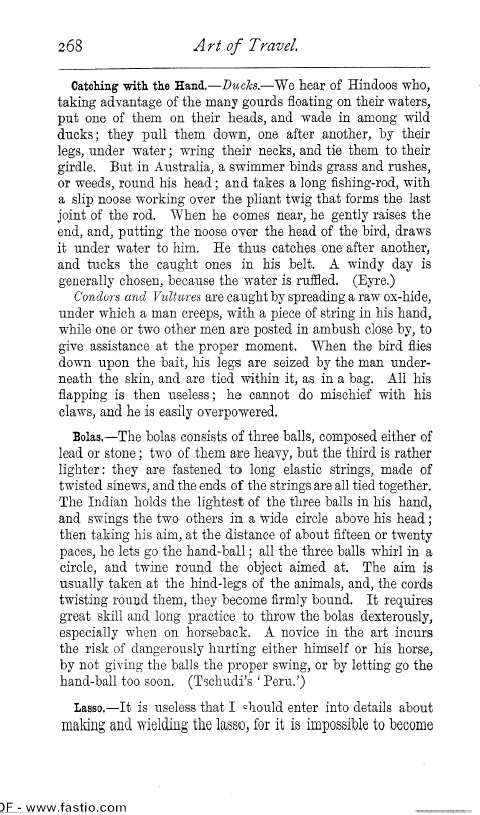268 Art of Travel.
Catching with the Hand.-Ducks.-We hear of Hindoos who, taking advantage of the many gourds floating on their waters, put one of them on their heads, and wade in among wild ducks ; they pull them down, one after another, by their legs, under water ; wring their necks, and tie them to their girdle. But in Australia, a swimmer binds grass and rushes, or weeds, round his head ; and takes a long fishing-rod, with a slip noose working over the pliant twig that forms the last joint of the rod. When he comes near, he gently raises the end, and, putting the noose over the head of the bird, draws it under water to him. He thus catches one after another, and tucks the caught ones in his belt. A windy day is generally chosen, because the water is ruffled. (Eyre.)
Condors and Vultures are caught by spreading a raw ox-hide, under which a man creeps, with a piece of string in his hand, while one or two other men are posted in ambush close by, to give assistance at the proper moment. When the bird flies down upon the bait, his legs are seized by the man underneath the skin, and are tied within it, as in a bag. All his flapping is then useless ; he cannot do mischief with his claws, and he is easily overpowered.
Bolas.-The bolas consists of three balls, composed either of lead or stone ; two of them are heavy, but the third is rather lighter : they are fastened to long elastic strings, made of twisted sinews, and the ends of the strings are all tied together. The Indian holds the lightest of the three balls in his hand, and swings the two others in a wide circle above his head ; then taking his aim, at the distance of about fifteen or twenty paces, he lets go the hand-ball ; all the three balls whirl in a circle, and twine round the object aimed at. The aim is usually taken at the hind-legs of the animals, and, the cords twisting round them, they become firmly bound. It requires great skill and long practice to throw the bolas dexterously, especially when on horseback. A novice in the art incurs the risk of dangerously hurting either himself or his horse, by not giving the balls the proper swing, or by letting go the hand-ball too soon. (Tschudi's ` Peru.')
Lasso.-It is useless that I Chould enter into details about making and wielding the lasso, for it is impossible to become
www.fastio.com

